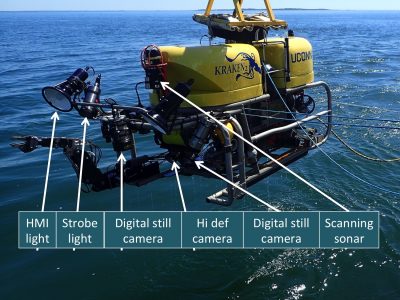Seafloor sampling via grabs and corers is not possible in some regions of Long Island Sound that feature coarse grained sediments, such as gravel, boulders or exposed granite ledge. Although these hard substrate habitats are spatially rare in Long Island Sound, especially in deep waters (>10 m) of the central and western basins they support seafloor communities that contribute uniquely to the rich biological diversity of the Sound. These areas are also preferred habitats for a wide range of species including fish, crustaceans, and molluscs of economic importance. Even in areas dominated by fine-grained sediments, some fragile organisms and biogenic structures that form habitats are damaged by physical sampling.
High resolution digital still and high definition video imagery provide the solution to documenting the diversity of the organisms that live on the surface of the hard substrates (i.e. the epifauna) in the Sound. There are two systems that support a range of imaging systems that are being used to characterize the hard substrates and the surface features of softer sediments.
The SEABOSS

In addition to taking sediment samples the SEABOSS is equipped with several imaging systems to document the seafloor. The primary imager is a down-looking high resolution Nikon digital still camera with external strobe light. A standard definition video camera mounted alongside the still camera has the same field of view that provides a real-time image to frame the still pictures. Paired parallel lasers mounted 20 centimeters apart pointed into the field of view of the digital still camera provide a constant measurement scale within each image. A forward-looking video camera allows the winch operator to see and avoid upcoming obstacles such as boulders. A high definition forward-looking GoPro camera with a wide field of view provides additional data on the nature of the seafloor and organisms not imaged by the digital still camera.
The Kraken2 (K2) Remotely Operated Vehicle (ROV)

The spatial complexity of some seafloor habitats, such as the boulder piles common in some areas of eastern Long Island Sound, are difficult to image extensively with platforms that drift passively with the prevailing currents like SEABOSS that must be be raised up to avoid collision with these outcrop features. The K2 ROV, conversely, with its six powerful thrusters is ideally suited to stopping and maneuvering around these bottom types. This maneuverability allows the K2 to image the vertical surfaces of boulder habitats, steep ledge walls and the troughs between sand waves that support mussel dominated communities in great detail with its hi-definition video and high resolution digital still zoom cameras. The K2 similarly supports parallel lasers spaced 10 cm apart to provide precise measurements of the size of organisms and objects seen in both the video and digital still images. All images were taken using artificial lighting (electronic flash or daylight color temperature lighting using HMI or LED sources) to enhance color saturation, edge sharpness, and depth of field.
To learn more about the features and capabilities of the K2 ROV and see videos of the vehicle in action, click here.